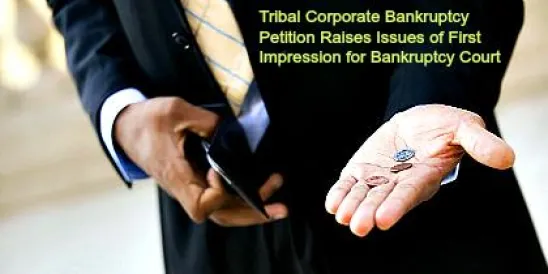On March 4, 2013, ‘SA’ NYU WA, Inc., a tribally-chartered corporation wholly owned by the Hualapai Indian Tribe, filed a Chapter 11 bankruptcy petition in the United States Bankruptcy Court, District of Arizona. This is a very important case for tribes and any party conducting business with tribes because the petition will raise a question of first impression for the Bankruptcy Court. The Bankruptcy Court will have to decide whether a tribal corporation is eligible to be a debtor under the Bankruptcy Code.
Federally recognized tribes likely are not eligible for bankruptcy protection. This is because Section 109 of the Bankruptcy Code provides direction as to who may be a debtor: only a “person” or a “municipality” may file a bankruptcy petition for relief. Neither “person” or “municipality,” as defined by the Bankruptcy Code, expressly includes or excludes an Indian tribe, and no reported court decisions have expressly addressed whether an Indian tribe is eligible to file for bankruptcy as person, municipality, or otherwise. The definition of “person” under the Bankruptcy Code excludes “governmental units” from being eligible debtors. The Bankruptcy Code defines a “governmental unit” as, among other things, an “other foreign or domestic government.” A number of courts have examined whether an Indian tribe is a “governmental unit” for purposes of applying the sovereign immunity provisions contained in Section 106 of the Bankruptcy Code. The majority of cases (including cases decided in the United States Bankruptcy Court for the District of Arizona) examining Section 106 of the Bankruptcy Code have found that an Indian tribe is a “governmental unit” within the meaning of the Bankruptcy Code. See In re Platinum Oil Properties, LLC, 465 B.R. 621 (Bankr. D.N.M. 2011) reconsideration denied, 11-09-10832 JA, 2011 WL 6293132 (Bankr. D.N.M. Dec. 12, 2011); Russell v. Ft. McDowell Yavapai Nation, 293 B.R. 34 (Bankr. D. Ariz. 2003); Davis Chevrolet Inc. v. Navajo Nation, 282 B.R. 674 (Bankr. D. Ariz. 2002); Turning Stone Casino v. Vianese, 195 B.R. 572 (Bankr. N.D.N.Y. 1995); Gilbert v. Shape, 25 B.R. 356 (Bankr. D. Mont. 1982); In re Sandmar Corp., 12 B.R. 910 (Bankr. N.M. 1981). Additionally, last year the United States Bankruptcy Court, Southern District of California dismissed a Chapter 11 petition filed by the Santa Ysabel Resort and Casino, a gaming enterprise of the Iipay Nation of Santa Ysabel, a federally recognized Indian tribe. The dismissal order of the Court simply granted the creditors’ motions to dismiss the petition.
However, in this case, the debtor alleges that it is a chartered tribal corporation, separate from the Hualapai Indian Tribe which owns it. The Bankruptcy Code allows a “corporation” to file for bankruptcy protection. The United States Bankruptcy Court, District of Arizona will have to decide whether a corporation organized under tribal law is a “corporation” for purposes of the Bankruptcy Code. In the non-bankruptcy context, the Seventh Circuit, in a case interpreting the federal Indian Gaming Regulatory Act and the federal diversity statute, 28 U.S.C. § 1332, held in Wells Fargo v. Lake of the Torches, 658 F.3d 684 (7th Cir. 2011), that a tribal corporation was a “corporation” and a citizen of the state of Wisconsin for purposes of determining federal diversity jurisdiction.
Outside of the bankruptcy context, federal and tribal law applicable to Indian tribes extends to a tribe’s wholly-owned instrumentalities and entities; however, whether the relief and remedies typically available with respect to non-tribal corporate debtors under the Bankruptcy Code is available to tribal corporate debtors, likely will be addressed by the Arizona bankruptcy court. For example, just as in the case of a tribe, land used or beneficially owned by a tribal corporation may actually be owned by the United States in trust for the tribe and therefore cannot be subject to sale or alienation in a bankruptcy case. Similarly, federal approvals may need to be obtained with respect to use or disposition of assets owned by a tribal corporation. If a tribal corporation is engaged in Indian gaming operations, which the debtor in the present case is not engaged in, federal law restricts the ownership of such gaming operations to the tribe on whose lands the tribal casino is located and requires third party managers to obtain federal approval.
The petition has the potential to make new law in other respects. For example, if a tribal corporation is found to be eligible as a debtor under the Bankruptcy Code, can creditors in future cases force tribal corporations into involuntary bankruptcy, despite the potential sovereign immunity of tribal corporations? If a tribal corporation is eligible as a debtor, can creditors “pierce” the corporate veil of the tribal corporation and reach assets of the shareholder tribe, or will the Bankruptcy Court follow non-recourse provisions that may be found in the tribal corporation’s organic documents or in its business contracts? Outside the context of bankruptcy, courts considering whether suits against a tribal corporate entity may also proceed against the parent tribe have declined to apply veil-piercing principles. See, e.g., Morgan Buildings & Spas, Inc. v. Iowa Tribe of Oklahoma d/b/a BKJ Solutions et al., Case No. CIV-09-730-M, 2011 WL 308889, *1 (Jan. 26, 2011 W.D. Okla.).
Given recent tribal defaults and restructurings, the outcome of this case will no doubt be watched by tribes and lenders to tribes.
Shawn Watts contributed to this article.





 />i
/>i

